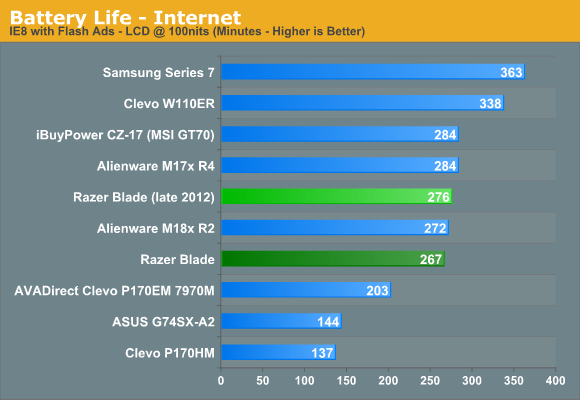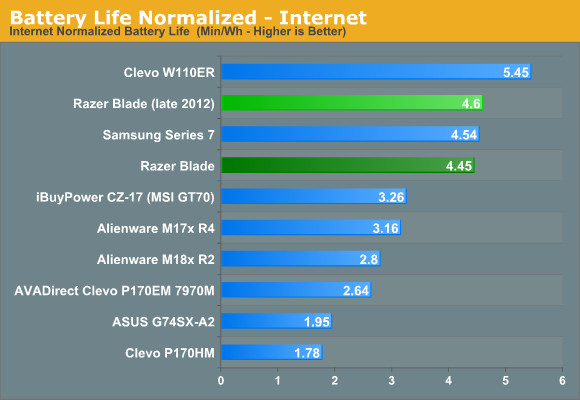The New Razer Blade: Thoroughly Reviewed
by Vivek Gowri on October 3, 2012 5:40 PM ESTRazer Blade (late 2012) - Battery Life
As before, battery life is quite solid, due in no small part to the wonders of NVIDIA’s Optimus graphics switching technology. It's amazing that gaming systems like the Blade, M17x, and M18x are all capable of four or more hours of real world usage, when just a couple of years ago this class of system had the battery serve as a glorified UPS. It's good that AMD has caught on with Enduro, and the Clevo that Jarred tested with the latest Enduro drivers was almost as good as what we're used to seeing from NVIDIA based notebooks. [Ed: Not really, actually, but that's more the fault of Clevo and not a problem with Enduro.]



With the Blade, we saw just over four and a half hours in our internet benchmark test, which is usually a good indicator of real-world system usage, and exactly five and a half in our ideal-case scenario. We noted a few percent improvement across the board versus the original Blade, which is pretty good when you consider how much computing power was added in the refresh. Razer is using the same 60Wh Li-poly battery pack as before, so the efficiency numbers look pretty good—one of the best in the class and just ahead of the Samsung Series 7 when we normalize for capacity. The only one that beat it on our charts is the Clevo W110ER, an 11.6" notebook with an i7 quad and a DDR3 GT 650M. The signficantly smaller (and dimmer) display means that it has lower power consumption. Given the sheer size of the Blade, it makes for a surprisingly good portable companion.

Another power-related detail I completely glossed over last time around was the 120W power adapter—it’s significantly smaller than any other 120W adapter out there. It’s slimmer than most of the 90W AC adapters I’ve seen, too. It’s a 19V brick that can draw up to 6.32A, and it weighs roughly three-quarters of a pound. It’s pretty impressive when you compare it to the shoebox-sized adapters that come with some of the Clevo systems these days. I’ve heard estimates from within Razer that it costs about six times as much to manufacture as a typical 120W adapter, and is one of the many custom-designed and custom-made parts in the Blade.










59 Comments
View All Comments
Cutebone - Wednesday, October 3, 2012 - link
"I'd also like to see an optional SSD-only configuratoin"Thanks for the write-up...wish I had $2,500 to spare...
robmuld - Wednesday, October 3, 2012 - link
I wish they offered a 16:10 option. Also, a proper navigation keys (PgUp/Dn and Home/End) section on the keyboard. This has sadly disappeared from most mobile keyboards nowadays, whereas it was more common years ago.andykins - Wednesday, October 3, 2012 - link
Great notebook and great review. I'm really glad you decided to dump PCMark7. I totally ignored the benchmarks from that suite in every review; I actually have no idea why Anandtech includes them, they're totally useless really.I have to say, I think if I had that amount of money to spend I would rather get a rMBP. If money was no object, however, I'd get both! ^^ But it begs the question why you didn't include rMBP (running Win7) in the results when you have a machine at hand? :)
Camacho - Wednesday, October 3, 2012 - link
Why is the Macbook "A different story entirely"? It is pretty much the same damn hardware as the Blade with a slightly slower GPU (GT 650m) and slightly faster CPU at base and all core clock. Blade beats it on single thread by 100MHz. @ 3.4GHz AND is cheaper. Plus it has your IPS display. Just wondering as you can just install Windows on the Mac. IPS laptop display is as fast as anything I have seen in a portable so not sure what the Razer guy was on about. ???.Camacho - Wednesday, October 3, 2012 - link
I was wrong the Macbook Pro has a faster CPU on all counts.will54 - Thursday, October 4, 2012 - link
Actually the Macbook has a faster GPU at there stock clocks since for some reason the MBP has a 165 mhz higher clock speed than other GDDR5 650M's. Not sure why they didn't just go with the GTX 660M.VivekGowri - Wednesday, October 3, 2012 - link
Because it's an OS X-based 15" machine that plays in a completely different size and weight class? You wouldn't compare a Porsche 911 and a Mercedes S-class just because they cost roughly the same and have a similar amount of power, right - same principle applies here.andykins - Thursday, October 4, 2012 - link
I disagree, Vivek. Maybe I am isolated case but I would very much like to see it compared to the rMBP. After all, the Razer is compared to laptops that weigh 3lb (50%+) heavier.VivekGowri - Thursday, October 4, 2012 - link
I dunno, there's just a huge difference between a 4.5lb 15" system and a 6.5lb 17" system in terms of form factor. Add in OS X, and I felt like they were different enough that they wouldn't be cross shopped much. M17x, on the other hand, is probably the biggest competitor for the Blade. The rMBP to me is an amazing system but I can't see a valid comparison. I guess maybe if you wanted the closest thing to the Blade in a 15" form factor, get an rMBP?Flunk - Wednesday, October 3, 2012 - link
It's a shame they don't make a 15" version of this. 17", no matter how thin is just too big to be reasonably portable. Heck, I would buy a 15" version of this at the same price. There really isn't much in that market space right now.